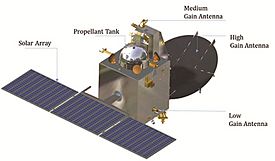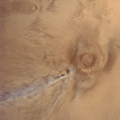Mars Orbiter Mission facts for kids

Mars Orbiter Mission Spacecraft (illustration)
|
|
| Names | Mangalyaan |
|---|---|
| Mission type | Mars orbiter |
| Operator | ISRO |
| Mission duration | Planned: 6 months Elapsed: 11 years, 2 months, 17 days |
| Spacecraft properties | |
| Bus | I-1K |
| Manufacturer | ISAC |
| Launch mass | 1,337.2 kg (2,948 lb) |
| BOL mass | ≈550 kg (1,210 lb) |
| Dry mass | 482.5 kg (1,064 lb) |
| Payload mass | 13.4 kg (30 lb) |
| Dimensions | 1.5 m (4.9 ft) cube |
| Power | 840 watts |
| Start of mission | |
| Launch date | 5 November 2013, 09:08 UTC |
| Rocket | PSLV-XL C25 |
| Launch site | Satish Dhawan FLP |
| Contractor | ISRO |
| Mars orbiter | |
| Orbital insertion | 24 September 2014, 02:00 UTC MSD 50027 06:27 AMT 4096 days / 3986 sols |
| Orbit parameters | |
| Periareon | 421.7 km (262.0 mi) |
| Apoareon | 76,993.6 km (47,841.6 mi) |
| Inclination | 150.0° |
|
Indian missions to Mars
|
|
The Mars Orbiter Mission (MOM) is a space probe that has been orbiting Mars since September 24, 2014. It is also known as Mangalyaan. This mission was launched by the Indian Space Research Organization (ISRO). It was India's first mission to another planet. India was the first Asian country to reach Mars. It was also the first country to succeed in reaching Mars on its very first try!
Contents
Why Explore Mars?
The main goal of the Mars Orbiter Mission was to learn how to send spacecraft to other planets. It also aimed to study Mars's surface, its rocks, and its atmosphere.
Studying Mars's Atmosphere
Scientists wanted to find out how much carbon dioxide and methane are in the Martian atmosphere. They also wanted to see how the solar wind and space radiation affect Mars. This helps us understand if Mars could have supported life in the past.
Learning About Mars's Moons
The mission also aimed to learn more about Mars's two moons, Phobos and Deimos. These small moons are very interesting to scientists.
Mission Timeline
The Mars Orbiter Mission had a clear timeline from launch to orbit.
Launching the Spacecraft
The Mangalyaan probe was launched on November 5, 2013. It took off from the Satish Dhawan Space Centre in India. The rocket used was a PSLV-XL C25.
Reaching Mars Orbit
After traveling through space for many months, the spacecraft arrived at Mars. It successfully entered Mars's orbit on September 24, 2014. This was a huge achievement for India.
Instruments on Board
The Mars Orbiter Mission carried several special tools, called instruments. These tools helped scientists gather information about Mars.
- Mars Colour Camera (MCC): This camera took amazing pictures of Mars. It showed us the planet's surface and its moons.
- Thermal Infrared Imaging Spectrometer (TIS): This instrument measured the heat coming from Mars. It helped scientists study the planet's surface and what it's made of.
- Methane Sensor for Mars (MSM): This tool looked for methane gas in Mars's atmosphere. Methane can be a sign of life, so finding it is very important.
- Mars Exospheric Neutral Composition Analyser (MENCA): This instrument studied the very top layer of Mars's atmosphere. It helped understand how gases escape from Mars.
- Lyman Alpha Photometer (LAP): This tool measured hydrogen in the atmosphere. This helps scientists understand how water might have been lost from Mars over time.
Related Missions
India's Mars Orbiter Mission is part of a bigger plan to explore Mars.
- List of Mars orbiters
- List of missions to Mars
- Mars Orbiter Mission 2 is the next planned mission to Mars from India.
Images for kids
-
Artist's rendering of the Mars Orbiter Mission spacecraft, with Mars in the background.
-
Mangalyaan's image of Arsia Mons
-
Image of Tharsis and Valles Marineris by Mangalyaan
See also
 In Spanish: Mars Orbiter Mission para niños
In Spanish: Mars Orbiter Mission para niños











